
S Scale America Husky Stacks
Michael Greene
updated February 2007
(please be patient -- there are a lot of images on this page to be loaded...)
 If you're a S enthusiast who is modeling in the modern era, the S Scale America Gunderson Husky Stack
well cars from Des Plaines Hobbies are must have cars for your fleet! In fact even if you're
not modeling the modern era, after you see them close up, you may decide
If you're a S enthusiast who is modeling in the modern era, the S Scale America Gunderson Husky Stack
well cars from Des Plaines Hobbies are must have cars for your fleet! In fact even if you're
not modeling the modern era, after you see them close up, you may decide  they are must have anyway. These are beautiful cars, and the detailed painting is amazing. I can even read all the small printing. I'm certain my photography can't
do these cars full justice, but here are a few pictures to wet your appetite. (Click on any photo in this article to get a larger view of it.) Further down this page you'll also find some links to several sites we've found with various intermodal photos from the prototype.
they are must have anyway. These are beautiful cars, and the detailed painting is amazing. I can even read all the small printing. I'm certain my photography can't
do these cars full justice, but here are a few pictures to wet your appetite. (Click on any photo in this article to get a larger view of it.) Further down this page you'll also find some links to several sites we've found with various intermodal photos from the prototype.
Trailer on Flat Car (TOFC) and Spine Cars with Trailers
When  it comes to intermodal cars, S scale has a fairly limited selection. S Helper
Service brought us the Trailer on Flat Car (TOFC), a 53'6" General Steel Casting Co. (GSC) flat car with a
it comes to intermodal cars, S scale has a fairly limited selection. S Helper
Service brought us the Trailer on Flat Car (TOFC), a 53'6" General Steel Casting Co. (GSC) flat car with a  35' trailer in a variety of road names and a variety of trailer names. American Models brought spine car sets to the market, 3 unit and 5 unit piggyback articulated cars with 40' trailers and a variety of trailer names.
35' trailer in a variety of road names and a variety of trailer names. American Models brought spine car sets to the market, 3 unit and 5 unit piggyback articulated cars with 40' trailers and a variety of trailer names.
Gunderson Husky Stack 48' Well Cars
Here's what Railway Age said in their March 1991 issue article on Gunderson Husky Stacks:
"Gunderson has orders for its new Husky-Stack car, with 150 units going to Trailer Train and 106 ordered by Burlington Northern. Trailer Train has also ordered 75 individual stand-alone wells from Thrall Car, along with 72 wells which will be drawbar-connected to form 18 four-well cars.
Gunderson calls Husky-Stack the fourth generation of double-stack technology to come out of its shop since 1985. This is a car designed primarily for the domestic container market and for the heavy loads involved in that market. Gunderson says Husky-Stack can handle 60% more load than the conventional intermodal well car. That makes it well suited for movement of such heavy-loading commodities as lumber, plywood and paper, as well as solid waste. The car is designed with a 48-foot well and uses 70-ton trucks. Light weight of the car is 52,600 pounds and capacity is 167,400 pounds, for a gross weight on rail of 220,000 pounds. The well will handle 20-, 40-, 45-, or 48-foot containers; units up to 53 feet in length can be handled on top. And, while the Trailer Train and BN cars will be delivered as true stand-alone wells, Husky-Stack can be drawbar-coupled to provide the smoother, slack-free ride associated with articulated intermodal equipment."
S Scale America's Husky Stack model
I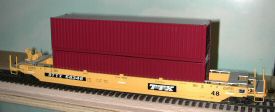 nitially S Scale America released kits for the Gunderson Husky Stack well cars. But more recently (2004), S Scale America released ready-to-run versions of the Gunderson Husky Stack well cars. They are available in several car numbers in both the TTX and CRLE paint schemes. The 48' well will
handle one container up to 48' or two 20' containers with another container stacked on top of the one in the well. Note that in a prototypical fashion you can stack a 53' container on top of a smaller 40', 45' or 48' container in the well. The S Scale America Husky Stacks use fine rolling S Helper Service trucks and are available with either hi-rail or scale wheelsets. The hi-rail
models come with American Flyer compatible couplers installed while the scale models come with Kadee 802 couplers. Upon receiving my models with scale wheels and Kadee couplers in January 2004, I did implement a coupler height improvement project (documented below) as the coupler was a little too high.
nitially S Scale America released kits for the Gunderson Husky Stack well cars. But more recently (2004), S Scale America released ready-to-run versions of the Gunderson Husky Stack well cars. They are available in several car numbers in both the TTX and CRLE paint schemes. The 48' well will
handle one container up to 48' or two 20' containers with another container stacked on top of the one in the well. Note that in a prototypical fashion you can stack a 53' container on top of a smaller 40', 45' or 48' container in the well. The S Scale America Husky Stacks use fine rolling S Helper Service trucks and are available with either hi-rail or scale wheelsets. The hi-rail
models come with American Flyer compatible couplers installed while the scale models come with Kadee 802 couplers. Upon receiving my models with scale wheels and Kadee couplers in January 2004, I did implement a coupler height improvement project (documented below) as the coupler was a little too high.
Trailers, Bulktainers and Cargo Containers
 In addition to offering prepackaged sets, both S Helper Service
and American Models offer their trailers for sale separately. (See their web sites for more information on availability.) Des
Plaines Hobbies offers a var
In addition to offering prepackaged sets, both S Helper Service
and American Models offer their trailers for sale separately. (See their web sites for more information on availability.) Des
Plaines Hobbies offers a var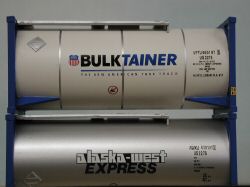 iety of kits for containers (40', 45', 48', and 53') and has also released several ready-to-use, very nicely detailed 20' bulktainer models suitable for the use in the well cars. The models of the bulktainers are very light at 0.7 ounces each, and could use some additional weight. I'm planning to drill a small hole in the bottom of mine and add some sand to provide additional weight. The hole can be easily plugged with
hot glue. Also note that although the bulktainers are stacked in the picture at the left, from what I can tell bulktainers were not double-stacked on the rails.
iety of kits for containers (40', 45', 48', and 53') and has also released several ready-to-use, very nicely detailed 20' bulktainer models suitable for the use in the well cars. The models of the bulktainers are very light at 0.7 ounces each, and could use some additional weight. I'm planning to drill a small hole in the bottom of mine and add some sand to provide additional weight. The hole can be easily plugged with
hot glue. Also note that although the bulktainers are stacked in the picture at the left, from what I can tell bulktainers were not double-stacked on the rails.
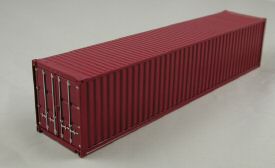 Just recently (January 2007) Tonkin Replicas released
a 40' Cargo Container and chassis in their 1:64 PEM Trucks line. I purchased my units from S Helper Service, but they may be available from other dealers as well. This cast metal cargo container and chassis is ready-to-use and is painted maroon with a black chassis. The cargo container separates from the chassis, features
Just recently (January 2007) Tonkin Replicas released
a 40' Cargo Container and chassis in their 1:64 PEM Trucks line. I purchased my units from S Helper Service, but they may be available from other dealers as well. This cast metal cargo container and chassis is ready-to-use and is painted maroon with a black chassis. The cargo container separates from the chassis, features 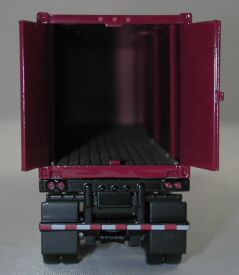 doors that open and a realistic interior. Weighing 12.2 ounces the cargo container provides some nice
doors that open and a realistic interior. Weighing 12.2 ounces the cargo container provides some nice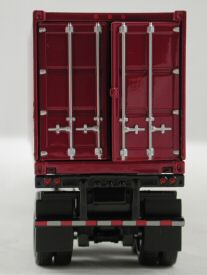 weight to the very light weight well car which substantially improves it's tracking on the rails. In fact even though the container is fairly heavy, a single container does not compress the springs on the trucks, and even with double stacking the containers as shown below, the car still rolls just fine. If you are interested
in double stacking the containers you will need some rubber cement, double sided tape or other adhesive in order to keep the top container from sliding off the bottom container.
weight to the very light weight well car which substantially improves it's tracking on the rails. In fact even though the container is fairly heavy, a single container does not compress the springs on the trucks, and even with double stacking the containers as shown below, the car still rolls just fine. If you are interested
in double stacking the containers you will need some rubber cement, double sided tape or other adhesive in order to keep the top container from sliding off the bottom container.
If you acquire some of the PEM Trucks models to use the cargo containers for well car loads, you might wonder what to do with the chassis that remain. Obvious choic es are to pair them with a truck cab and locate them
at the loading/unloading area, or just put the chassis in an intermodal yard if you have one on your layout. There are vertical chassis storage racks to allow storage of more chassis in a smaller area. If you don't have an intermodal yard (or room for one), you might consider using them as loads. Chassis are moved by rail either singly on flat cars, or in special chassis racks.
See the prototype photos section of this article for some examples.
es are to pair them with a truck cab and locate them
at the loading/unloading area, or just put the chassis in an intermodal yard if you have one on your layout. There are vertical chassis storage racks to allow storage of more chassis in a smaller area. If you don't have an intermodal yard (or room for one), you might consider using them as loads. Chassis are moved by rail either singly on flat cars, or in special chassis racks.
See the prototype photos section of this article for some examples.
Below are some additional photos showing various combinations of these items.
 |
 |
 |
 |
 |
 |
For Further Study
If you're interested in further reading on intermodal modeling you will find numerous articles in the railroad and model railroad press. Use the Model Train Magazine Index to help find articles of interest. There is an especially good series of articles in Model Railroading magazine starting around 1994. They have been collected into a two volume set of books available from the publisher (Highland Station) and in many hobby shops -- the books are titled Intermodal Modeler's Guide Volume 1 and Volume 2. Another book that may be of interest is The Model Railroader's Guide to Intermodal Equipment and Operations by Jeff Wilson and published by Kalmbach, also available in many hobby stores.
If you're interested in photos of the prototype these are some sites we have found that have good collections:
-
The Greenbrier Companies (manufacturer of various stack cars)
Another good resource is the Yahoo Group named modelintermodal. click to join the Yahoo Group ModelIntermodal
S Scale America Husky Stacks Coupler Height Improvement Project
by Michael Greene & Tom Robichaud
February 2004
I purchased several of the Husky Stack well cars from S Helper Service (1-800-465-0303 or via email) prior to the large Springfield, MA show in early February 2004. I was advised that the couplers were a bit too high on the cars before purchasing, but felt that could be resolved. Well the cars arrived just a few days before the show, and I was very impressed with the cars. As I considered my approach to resolving the coupler height, I wanted more information on the prototype, so I pulled the July 1992 issue of Railroad Model Craftsman from my files. That issue has a very good article on pages 71-75 by James Panza on the prototype Gunderson Husky Stack well cars with measurements and other details. There are also some additional prototype photos in Paul Marshall's North America Railroad Photographs collection in the Intermodal section as well as the other links listed above.
After looking at the car, and the information on the prototype, I decided against relocating the coupler on the model. The pocket is integrated with the model. I could not see any way 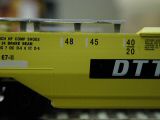 that wouldn't result
in an awkward looking
model, and one that was much less like the prototype. I also noted that the model car as delivered was a little high, when measuring the height from the rail to the container support surface. Then I made a number of measurements about what would be required in terms of lowering the coupler, and after looking at the options, I noticed in the article that some of the prototype cars were delivered with 28" wheels and some with 33" wheels. The smaller wheel version obviously had a lower load limit.
that wouldn't result
in an awkward looking
model, and one that was much less like the prototype. I also noted that the model car as delivered was a little high, when measuring the height from the rail to the container support surface. Then I made a number of measurements about what would be required in terms of lowering the coupler, and after looking at the options, I noticed in the article that some of the prototype cars were delivered with 28" wheels and some with 33" wheels. The smaller wheel version obviously had a lower load limit.
The net of it all was that we ended up making three simple modifications to the cars in order to improve the coupler height. One modification was to simply remove the truck spacer. The second modification was to replace the 33" wheelsets that come with the model, with 26" wheelsets that I obtained from NorthWest Short Line (NWSL). (They did not have 28" wheels available.) While NWSL does not stock 26" standard gauge wheelsets with
pointed axles for SHS trucks, they will be happy enough to make them up. 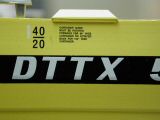 (In fact I can't
say enough kind words about the folks and service from NWSL -- I called them late Wednesday afternoon, and they took my order, made up the wheelsets, and I had wheelsets in my hands Friday before noon -- in time to take to the show! And they are really nice weathered nickel silver wheelsets to boot!)
(In fact I can't
say enough kind words about the folks and service from NWSL -- I called them late Wednesday afternoon, and they took my order, made up the wheelsets, and I had wheelsets in my hands Friday before noon -- in time to take to the show! And they are really nice weathered nickel silver wheelsets to boot!)
The third modification we made was to remove the post on the bolster into which the kingpin (truck screw) is screwed. We replaced it with a very thin washer to provide a bit more clearance since the post was now gone. With these modifications we had a very nice match up on the Kadee 802 couplers.
While I'm not a modern modeler, these are really nice looking cars, and when loaded with containers look really nice running on the layout! Now I'm just waiting on the box containers from Des Plaines to add to the rest of my string of them. My recommendation - don't miss out on adding these to your railroad!
For those interested in the details of the modifications, here are some more facts, figures, and photos (captions below each photo):
|
Unmodified car, showing coupler height alignment with Kadee 802 gauge (End A) |
Unmodified car, showing coupler height alignment with Kadee 802 gauge (End B) |
Close-up view of coupler pocket -- note integration with rest of car body |
Also notice the fine printing on either side - just another example of the amazing painting |
|
My measurements indicated that the coupler height difference on End A was about 0.100" and on End B about 0.123". Some of that difference between the two is due to the fact that the coupler appears to tilt up in the pocket a bit more on End B. Note I also checked two cars and obtained similar measurements. (For comparison the knuckle face on the KD802 is 0.189".) The first modification was to remove the spacer between the truck and bolster. This spacer is 0.084" thick, but at first glance it appears you only get an improvement of about 0.013" since a mounting post fills most of the spacer. Also see the photo further down showing the post on the bolster. It turns out that removing the spacer, allows the truck to seat around the smaller portion of the post, getting an additional 0.030" improvement, for a total improvement of about 0.043" when removing the spacer. The next modification was to swap the 33" wheelsets for the 26" wheelsets from NWSL. NWSL advised that this would provide 0.050" improvement, and my measurement after installation in the trucks validated that, and perhaps a thousandth or two more. |
|||
|
Coupler height on End A after removing the spacer and swapping in the 26" NWSL wheelsets |
Coupler height on End B after removing the spacer and swapping in the 26" NWSL wheelsets |
Original 33" wheelsets |
Now with NWSL 26" wheelsets |
|
At this point we have about a 0.093"-0.095" improvement in coupler alignment as you can see from the photos immediately above. I believe that many folks will find it acceptable to stop here. These modifications also lower the car slightly bringing it very close to the indicated prototype height from the railhead to the container support, as indicated in the RMC article. On many of my cars I opted for an additional modification. Modelers may want to make modifications one and two (above), and then view and run the model to decide if they want to make this additional modification. I used my rail cutters to actually remove the post on the bolster entirely, cutting it off flush with the bolster and using a few quick passes with a file to level it out. Then I inserted a thin washer in it's place. I used a standard 0.020" brass colored washer that comes on the screw used in mounting S Helper Service trucks. (Note I used extra washers -- not the ones that came on these trucks!) The large portion of the post is approximately 0.040" high, so taking it away, and adding back the washer provides an additional improvement of approximately 0.020". |
|||
|
Post as it comes on unmodified car. The small part will seat in the SHS truck when the spacer is removed. |
This is how it looks after removing the post (cut off flush with bolster), and adding the thin washer in its place. |
Coupler height alignment on End A after this mod |
Coupler height alignment on End B after this mod |
|
This last modification actually lowers the model car slightly below the prototype car height. So in my view this last modification is a trade-off. |
|||
P.S. For those running American Flyer compatible wheels & American Flyer compatible couplers, these cars are also available in that configuration and do not require these modifications.

Copyright (c) 2002-2012 C.M.Greene. All rights reserved.




















